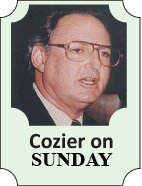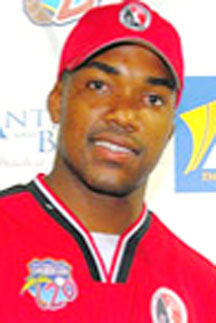West Indies have only once toured England without at least one truly special, not to mention great, batsman in their ranks.
George Challenor, the dominant Barbadian opener, was the torch bearer with 1,550 runs in 1923, double those of the next man. It was the last tour before Test status was attained in 1928 by which time Challenor was 40 and well past his best.
It was not until the arrival of George Headley, “Atlas”, who stood alone for the West Indies – and alongside, arguably even above, the legendary Don Bradman – in their formative years in Test cricket throughout the 1930s, that the sequence began in earnest.
Headley begat the Three Ws, Frank Worrell, Everton Weekes and Clyde Walcott, who amassed awesome runs together for the decade after World War II.

The quality of West Indian batsmanship was palpably dwindling even as Lara’s glittering career was ended so that for their 15th Test series in England, starting at Lord’s on Thursday, the only remaining link to such a proud lineage is Lara’s tried and trusted partner, the enduring, unique Shivnarine Chanderpaul.
His 10,005 Test runs after a career of 18 years place him second only to Lara among West Indians but, in his 38th year, he is in the twilight of his days of saving lost causes with his single-minded application.
There is the understandable fear that, after he finally and, no doubt, reluctantly, calls it a day, an extended period of batting famine is to follow, more especially given the embarrassingly meager totals that have featured in the regional game for some years now.
One specially gifted young man carries the heavy burden of expectancy that he can keep the flame at least flickering and provide the inspiration to those around him.
Darren Bravo is 23 and, as is constantly if not unsurprisingly repeated, is a blood relation of Lara. His silky left-handed strokeplay, his mannerisms, even his facial resemblance are impossible to ignore.
When he steps onto Lord’s for the first time this week, he brings with him a healthy average of just under 50 runs an innings after 16 Tests. There was a maiden hundred, 195 to be exact, in Bangladesh last November followed by two more in India in the three Tests that followed.

After unsatisfactory returns (186 runs at 36.8 with only one half-century) in a generally low scoring home series against Australia that ended only days before departure for England, Bravo compiled scores of 51 and 57 against the England Lions in a manner than drew flattering words from usually hard-marking writers in the English press, most former Test players.
Yet, even though the weather was cold and damp and the pitch reported to be especially seamer-friendly on the opening day, he didn’t make it far past the 50s.
It is a statistic that will bother him for, as his illustrious relative illustrated, such starts should be converted into massive scores. No one expects a triple or a quadruple hundred just yet but 50s do ability such as young Bravo’s an injustice. Lord’s, with all its tradition, would be the ideal place to put it right.
It was the challenge of pitting himself against the No.1 team in their own environment that prompted Bravo to choose this tour ahead of a US$100,000 contract with the Deccan Chargers in the Indian Premier League (IPL). He is aware that he will ultimately be judged, as all the celebrated West Indians before him, on his performances in Test cricket, not Twenty20.
While Bravo has taken the spotlight, another 23-year old left-hander, similar in the ease with which he gathers his runs, emerged from what had been a catastrophic two days for the team against the England Lions at Northampton yesterday to prove that he, too, is one for the future.
Prospering in what has been rare sunshine since the team’s arrival, Kieron Powell stroked a hundred that saved West Indian blushes and gave some credence to the optimism of West Indies Cricket Board (WICB) chief executive Ernest Hilaire, stated during the week in his “star team rather than team of stars” discourse when he spoke of this side’s “greater commitment to fight to the very end.”
They had certainly got themselves into a hole and Powell’s successive century partnerships with Bravo and Chanderpaul dug them out of it.Not that it would save them from defeat by what, after all, is the England reserve team. The top guns James Anderson, Stuart Broad and Graeme Swann will be waiting at Lord’s. But it was the first glimmer of hope on what had been a depressing start to the campaign.
To be able to somehow extend the three Tests into “epic five-day battles” (Hilaire’s words) is presently a far-fetched notion. Still, if it does and there is even a well-earned draw or two, Hilaire would have his evidence that is it a team “battling to win and believing that it can in fact achieve victories.”
In keeping with the present way of the cricket world, the buildup to Thursday was already so brief as to be unsatisfactory.
The young West Indians on their initial first team tour of England – eight of the 15, Bravo and Powell among them – have been tested to the limit in what play there has been by conditions and weather that has turned out to be late winter rather than middle of spring.
To add to the woes, Narsingh Deonarine and Asad Fudadin were held up for so long awaiting British visas in Kingston that they missed the only two available matches, the 34 overs they got in against Sussex at rain-sodden Hove and the subsequent struggles against the Lions at dry, but still wintry, Northampton. It is highly unlikely that either would be thrown in at the deep end at Lord’s.
Who should be is a question that will cause the tour selectors a few sleepless nights between now and Thursday morning.
Adrian Barath (16, 8 and 14) is short of runs, as he was in the series against Australia, but there is no alternative opening batsmen to himself and Powell. Kirk Edwards (8,0,4) is even shorter but there is also no other reputable No.3 to take his place.
Then there is riddle of the composition of the attack. The early season conditions argue for three fast bowlers, Fidel Edwards, Ravi Rampaul and Kemar Roach, along with Darren Sammy’s medium-pace, but that would mean the omission of Shane Shillingford just a couple of weeks after his 10-wickets return against Australia in Dominica and leave spin in the solitary care of Marlon Samuels.
And, even with Edwards, Rampaul, Roach and Shillingford against the Lions , there was the inability to close out an innings, a failing so prevalent in recent times.
They sent down 17 no-balls between them, two from Edwards negating wickets, and the emerging Englishmen pushed on from 98 for five to 341 before they were finally dislodged reviving memories of the repeated late order revivals by India and Australia in the last two series when the West Indies had them at their mercy.
Unless such flaws are quickly erased, there are unlikely to be any “epic five-day battles” over the next few weeks.





